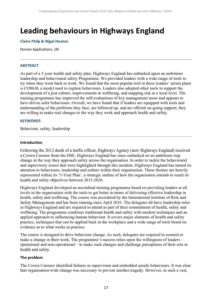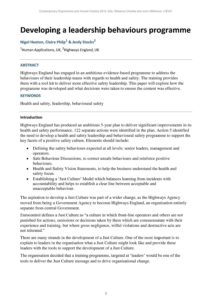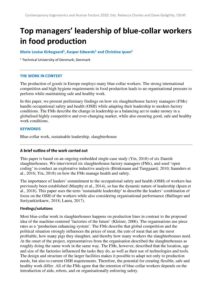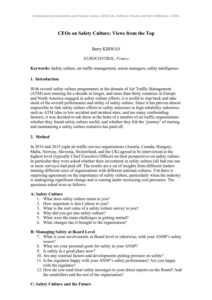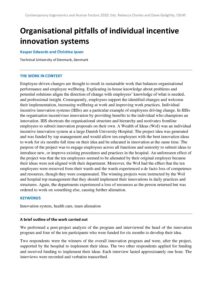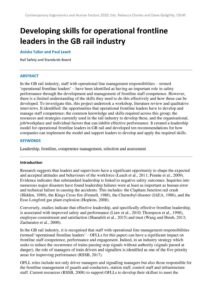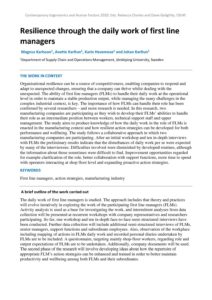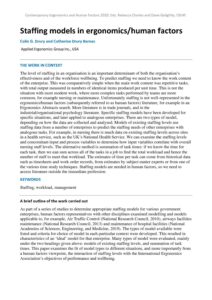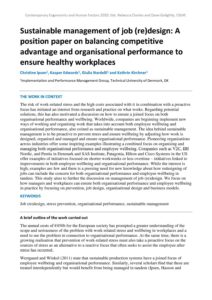Leadership
Leading behaviours in Highways England
| Document | Author Claire Philp & Nigel Heaton |
| Abstract As part of a 5-year health and safety plan, Highways England has embarked upon an ambitious leadership and behavioural safety Programme. We provided leaders with a wide range of tools to try when they went back to work. We found that the most popular tool in these leaders’ action plans is COM-B, a model used to explain behaviours. Leaders also adopted other tools to support the development of a just culture, improvements in wellbeing, and mapping risk at a local level. The training programme has improved the self-evaluations of key management areas and appears to have driven safer behaviours. Overall, we have found that if leaders are equipped with tools and understanding of the problems they face, are followed up, and are offered on-going support, they are willing to make real changes to the way they work and approach health and safety. |
Developing a leadership behaviours programme
| Document | Author Nigel Heaton, Claire Philps & Andy Stocks |
| Abstract Highways England has engaged in an ambitious evidence-based programme to address the behaviours of their leadership teams with regards to health and safety. The training provides them with a tool kit to deliver more effective safety leadership. This paper will explore how the programme was developed and what decisions were taken to ensure the content was effective. |
Top managers’ leadership of blue-collar workers in food production
| Document | Author Marie Louise Kirkegaard, Kasper Edwards and Christine Ipsen |
| Abstract The production of goods in Europe employs many blue-collar workers. The strong international competition and high hygiene requirements in food production leads to an organisational pressure to perform while maintaining safe and healthy work. In this paper, we present preliminary findings on how six slaughterhouse factory managers (FMs) handle occupational safety and health (OSH) while adapting their leadership to modern factory conditions. The FMs describe the change in leadership as a balancing act to make money in a globalised highly competitive and ever-changing market, while also ensuring good, safe and healthy work conditions. |
CEOs on Safety Culture: Views from the Top
| Document | Author Barry KIRWAN |
| Abstract |
Organisational pitfalls of individual incentive innovation systems
| Document | Author Kasper Edwards and Christine Ipsen |
| Abstract Employee-driven changes are thought to result in sustainable work that balances organisational performance and employee wellbeing. Explicating in-house knowledge about problems and potential solutions aligns the direction of change with employees’ knowledge of what is needed, and professional insight. Consequently, employees support the identified changes and welcome their implementation, increasing wellbeing at work and improving work practices. Individual incentive innovation systems (IIISs) are a particular example of employees driving change. In IIISs the organisation incentivises innovation by providing benefits to the individual who champions an innovation. IIIS shortcuts the organisational structure and hierarchy and motivates frontline employees to submit innovation proposals on their own. A Wealth of Ideas (WoI) was an individual incentive innovation system at a large Danish University Hospital. The project idea was generated and was funded by top management and would allow ten employees with the best innovation ideas to work for six months full time on their idea and be educated in innovation at the same time. The purpose of the project was to engage employees across all functions and seniority to submit ideas to introduce new, or improve existing procedures and practices in the hospital. An unforeseen effect of the project was that the ten employees seemed to be alienated by their original employer because their ideas were not aligned with their department. Moreover, the WoI had the effect that the ten employees were removed from their wards and the wards experienced a de facto loss of competence and resources, though they were compensated. The winning projects were instructed by the WoI and hospital top management that they should implement their innovations in daily practices and structures. Again, the departments experienced a loss of resources as the person returned but was ordered to work on something else, causing further alienation. |
Identifying work system components and constraints of cancer multidisciplinary team meetings
| Document | Author Eva-Maria Carman, Giulia Miles, Sarah Gregory, Gemma Bristow, Eleanor Robinson, James Catton, Alastair Ross and Bryn Baxendale |
| Abstract Multidisciplinary teams have been introduced into cancer care to improve quality of care and are now considered the gold standard for the management of cancer patients in the UK. Meetings of these teams provide an opportunity for experts to discuss the best possible treatment options for the patient. Trends show that referral numbers to these meetings are increasing, placing strain on the capacity of meetings to function optimally. This in turn has cognitive and workload implications for staff involved. Promoting MDT Excellence is a project that aims to examine the variation in practice of these meetings across one NHS Trust and to understand the challenges they are currently facing. In the first phase of this project, a systems analysis of cancer multidisciplinary teams was conducted for the purpose of identifying system constraints and resource issues. A total of twelve meetings were observed, and 42 staff from four specialties were interviewed. Using the SEIPS 2.0 model, key work system components and constraints for multidisciplinary team meetings were identified for the people involved, the tasks, tools and technology, organisation of work, internal environment and external environment. Furthermore, aspects that promoted efficient ways of working and positive outcomes were captured. Examples identified included adopting a more structured agenda, real time digital notetaking and different work organisation techniques, such as distribution of responsibilities and the scheduling of patient groups to be discussed during the meeting. These results provide the basis for a multifaceted approach for system improvement for this work process. |
Developing skills for operational frontline leaders in the GB rail industry
| Document | Author Anisha Tailor and Paul Leach |
| Abstract In the GB rail industry, staff with operational line management responsibilities – termed ‘operational frontline leaders’ – have been identified as having an important role in safety performance through the development and management of frontline staff competence. However, there is a limited understanding of the skills they need to do this effectively and how these can be developed. To investigate this, this project undertook a workshop, literature review and qualitative interviews. It identified: the opportunities that operational frontline leaders have to develop and manage staff competence; the common knowledge and skills required across this group; the resources and strategies currently used in the rail industry to develop these, and the organisational, job/workplace and individual factors that can inhibit effective performance. It created a leadership model for operational frontline leaders in GB rail and developed ten recommendations for how companies can implement the model and support leaders to develop and apply the required skills. |
Resilience through the daily work of first line managers
| Document | Author Magnus Karlsson, Anette Karltun, Karin Havemose and Johan Karltun |
| Abstract Organisational resilience can be a source of competitiveness, enabling companies to respond and adapt to unexpected changes, ensuring that a company can thrive whilst dealing with the unexpected. The ability of first line managers (FLMs) to handle their daily work at the operational level in order to maintain a stable production output, while managing the many challenges in the complex industrial context, is key. The importance of how FLMs can handle their role has been confirmed by several researchers – and more research is needed. In this research, two manufacturing companies are participating as they wish to develop their FLMs’ abilities to handle their role as an intermediate position between workers, technical support staff and upper management. The study aims to produce knowledge of how the daily work in the role of FLMs is enacted in the manufacturing context and how resilient action strategies can be developed for both performance and wellbeing. The study follows a collaborative approach in which two manufacturing companies are participating. After an initial workshop and ten in-depth interviews with FLMs the preliminary results indicate that the disturbances of daily work per se were expected by many of the interviewees. Difficulties involved were diminished by developed routines, although the information about those sometimes were difficult to find. Improvement opportunities regarded for example clarification of the role, better collaboration with support functions, more time to spend with operators interacting at shop floor level and expanding proactive action strategies. |
Staffing models in ergonomics/human factors
| Document | Author Colin G. Drury and Catherine Drury Barnes |
| Abstract The level of staffing in an organisation is an important determinant of both the organisation’s effectiveness and of the workforce wellbeing. To predict staffing we need to know the work content of the enterprise. This was comparatively simple when the main work content was repetitive tasks, with total output measured in numbers of identical items produced per unit time. This is not the situation with most modern work, where more complex tasks performed by teams are more common, for example nursing or maintenance. Unfortunately staffing is not well-represented in the ergonomics/human factors (subsequently referred to as human factors) literature, for example in an Ergonomics Abstracts search. More literature is in trade journals, and in the industrial/organisational psychology literature. Specific staffing models have been developed for specific situations, and later applied to analogous enterprises. There are two types of model, depending on how the data are collected and analysed. Models of existing staffing levels use staffing data from a number of enterprises to predict the staffing needs of other enterprises with analogous tasks. For example, in nursing there is much data on existing staffing levels across sites in a health service, such as the UK’s National Health Service. We can examine the staffing levels and concomitant input and process variables to determine how input variables correlate with overall nursing staff levels. The alternative method is summation of task times: if we know the time for each task, then we can sum across all of the tasks in a job to find the total workload and hence the number of staff to meet that workload. The estimates of time per task can come from historical data such as timesheets and work order records, from estimates by subject matter experts or from one of the various time study techniques. Staffing models are needed in human factors, so we need to access literature outside the immediate profession. |
Sustainable management of job (re)design: A position paper on balancing competitive advantage and organisational performance to ensure healthy workplaces
| Document | Author Christine Ipsen, Kasper Edwards, Giulia Nardelli and Kathrin Kirchner |
| Abstract The risk of work-related stress and the high costs associated with it in combination with a proactive focus has initiated an interest from research and practice on what works. Regarding potential solutions, this has also motivated a discussion on how to ensure a joined focus on both organisational performance and wellbeing. Worldwide, companies are beginning implement new ways of working and organising work that takes into account both employee wellbeing and organisational performance, also coined as sustainable management. The idea behind sustainable management is to be proactive to prevent stress and ensure wellbeing by adjusting how work is designed, organised and managed and ensure organisational performance. Pioneering organisations across industries offer some inspiring examples illustrating a combined focus on organising and managing both organisational performance and employee wellbeing. Companies such as V2C, IIH Nordic, and Pentia in Denmark and SAS Institute, Patagonia, Hilton and Cisco Systems in the US offer examples of initiatives focused on shorter workweeks or less overtime – initiatives linked to improvements in both employee wellbeing and organisational performance. While the interest is high, examples are few and there is a pressing need for new knowledge about how redesigning of jobs can include the concern for both organisational performance and employee wellbeing in tandem. This study aims to further the discussion on management of job (re)design. We focus on how managers and workplaces can ensure both organisational performance and employee wellbeing in practice by focusing on prevention, job design, organisational design and business models. |
Assessment of Leadership and Management for Safety – where do we start?
| Document | Author Jonathan BERMAN, Shona WATSON and Michael ARGENT |
| Abstract |

